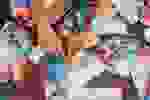
How to Choose Color Schemes That Make an Impact
At Issuu, we’re proud to host content creators from all backgrounds, all over the world, and with different areas of expertise. From realtors looking to create a digital hub for real estate listings to nonprofits working to amplify social impact messages, Issuu users form a strong global community of creators. With that in mind, we understand that not everyone who uses our platform has a brand or design background. That’s why we’ve put together this guide to help you own your digital presence through content, starting with color.
Color Psychology
Color psychology studies how certain colors impact human behavior, and these findings can have a huge impact on how messages are perceived. Popular opinion, era-specific trends, and even cultural background can factor into how we feel about a particular shade. The choices you make in your palette will help set the appropriate tone for your content, whether that’s to grab immediate attention or attract audiences through subtle messaging.
Color and Brand Identity
When you think about the brands you use most, you might not consciously think about the color of the design, but the way it’s packaged and marketed all play a vital role in purchasing decisions. According to research from analytics expert Neil Patel, color is king. In one study, 85% of participants said they base their purchase of a specific product on color!
Customers have hundreds of options. Decision fatigue is real, and with all the different names and styles, it can be hard to narrow it down. In a world of endless details fighting for your audience’s attention, the best way to pull them in is to meet them where they are.
When planning your brand voice and style guide, think about who you cater to and the types of consumers you’re looking to attract. Dive into the community you’re working for and get to know what they want to see and experience. It’s often more straightforward than you think, especially if your product or message is clearly defined. You’re already creating a product or offering a service someone wants, so now you just need to convey it with the right branding.
Types of Color Schemes
The great thing about color is that you can create a nearly endless set of combinations. Even within the same industry, the variations are far-reaching. Here are some of the most popular color schemes and a few ideas about which audience you speak to with the color scheme you select.

Analogous Color Schemes
Analogous colors are typically a set of three colors that sit next to each other on the color wheel. Think of a design that uses warm tones and combines red, orange, and amber. These rich colors look beautiful together and would pair well with combinations of those three colors or a composite color like brown.
Our brains also seem to respond well to seeing similar colors working in harmony. Research suggests that analogous color schemes increase the aesthetic appeal of a logo or brand design. In fact, it seems we trust this palette enough to bank on it (literally); some of the most successful examples of logos using analogous color schemes are PayPal and Mastercard.
Complementary Color Schemes
Complementary colors exist on opposite ends of the color wheel from each other. An ideal choice for designs that want to draw the eye, complementary color schemes are a sure way to stand out. While the contrast creates visual tension, they make excellent neighbors with the right tones and hues. Typically one color will be the dominant shade while the other is there as an accent.
Complementary colors can compete and leave a lasting impact and a foundational feeling. Some popular brands like Fanta, Heineken, and Visa have discovered this for themselves and used that in their branding over the years. As a result, logos using complementary color schemes feel sturdy and reliable.

Monochromatic Color Schemes
The monochromatic color scheme is a classic choice. Monochrome has become synonymous with luxury and taste thanks to its prominence in the fashion industry through renowned brands like Burberry and Chanel, along with rising stars like Fear of God or Telfar’s accessory collections. When you want a design that feels clean, elegant, and a tad luxurious, opting for a monochromatic color scheme is always a top choice.
Pastel Color Schemes
A favorite across generations, pastels always come back into style. While the previous decade saw brand logos with blues conveying tech-savvy authority and home design embraced jewel tones and cool grays, the 2020s are leading us back to a softer tone. Pastel color schemes are lighter yet very playful, conveying feelings of softness, positivity, joy, and sophistication. Think of the colorful, preppy houses along Rainbow Row in Charleston or the local ice cream parlor that you never cease craving. It’s no surprise that pastels are popular among food, beauty, health & wellness, and household brands. Visual-forward companies, take note of the pastel color palette.
Trending Color Schemes in 2022
If you’re looking for something fresh for a limited campaign or product launch, it’s always good to know what’s trending. We’ve already seen 2022 bring together contrasting combinations and a healthy dose of nostalgia. Here are some of the color schemes you’ll spot online this year.

Y2K Aesthetics
Referring to the era around the year 1999 when the world feared the clock striking midnight on New Years' Eve would result in a complete technology collapse – the Y2K design trend is all about color combinations that feel futuristic and a bit whimsical. The color schemes borrow from two popular themes: neon and pastels.
We already covered how pastels bring a light element to designs. To use them in this trend, however, you can design around one or a few individual colors and create a monochromatic or analogous color scheme. Gradients are also common, reminiscent of the glow from a neon sign. Some of the most prominent colors in this trend are purple, blue, pink, green, and 2022’s Pantone Color of the Year, ‘very peri’.
Nature Hues
Sometimes the best design is the one that comes more naturally to us. In this case, nature is our guide for finding color combinations that suit each other as effortlessly as green grass and blue skies. Whether it’s landscape photography, a swim in the lake, or a long hike in the hills, it’s easy to find inspiration for this color palette at a time when most of us are looking for ways to re-engage with the calming elements of the great outdoors.
Colorful Minimalism
Contemporary minimalism, sometimes called new minimalism, is a trend that’s been emerging for years. The mid-2010s saw the world embracing a new version of it through physical examples like the KonMari Method to carefully curated Instagram feeds and YouTube videos. A lot of the color schemes floating around at the time were light, airy, and unsaturated monochrome. Colorful minimalism has been gaining more popularity. The primary color palette explored through Bauhaus is an excellent example of how to embrace this classic.
While digital design is ever-evolving, color remains one of the essential elements to consider. Your message takes center stage when you create a compelling narrative with your color scheme. Whether you see your brand enjoying the refinement of monochrome colors or the eye-catching element of a complementary color scheme, you now know how to make the best choice for your message.
Now that you’ve thought about how to build your best color scheme, let Issuu help you share it with the world.
